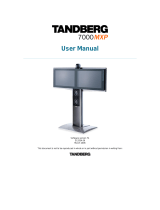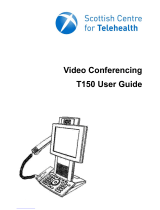
Table Of Contents
iii
3.12.5 Assign Floor and Release Floor from Participant ............................................... 54
3.12.4 Chair Control....................................................................................................... 55
3.12.6 View Site and End View...................................................................................... 55
3.12.7 Disconnect Participant......................................................................................... 55
3.12.8 Terminate Meeting .............................................................................................. 55
3.12.9 More about MultiSite (embedded MCU).............................................................. 55
3.13 Control Panel ............................................................................................................... 58
3.13.1 User Guide.......................................................................................................... 58
3.13.2 Streaming............................................................................................................ 59
3.13.3 Far End Control................................................................................................... 60
3.13.4 Camera Preset.................................................................................................... 61
3.13.5 Camera Tracking................................................................................................. 61
3.13.6 Text Chat............................................................................................................. 62
3.13.7 System Information ............................................................................................. 62
3.13.8 Administrator Settings......................................................................................... 63
3.13.9 Restart................................................................................................................. 63
4 Administrator Settings .......................................................................................................... 64
4.1 General Settings ............................................................................................................ 65
4.1.1 Language .............................................................................................................. 65
4.1.2 System Name........................................................................................................ 66
4.1.3 Dual Monitor.......................................................................................................... 66
4.1.4 Autoanswer ........................................................................................................... 66
4.1.5 Max Call Length .................................................................................................... 67
4.1.6 Global Phone Book Settings ................................................................................. 67
4.1.7 Permissions........................................................................................................... 67
4.1.8 Screen Settings..................................................................................................... 68
4.1.9 Software Options................................................................................................... 71
4.2 Menu Settings................................................................................................................ 73
4.2.1 Menu Timeout In Call............................................................................................ 73
4.2.2 Welcome Menu ..................................................................................................... 74
4.2.3 Welcome Picture................................................................................................... 74
4.2.4 Logo....................................................................................................................... 74
4.2.5 Menu on TV........................................................................................................... 75
4.2.6 Menu on PC .......................................................................................................... 75
4.2.7 Display Welcome Text........................................................................................... 75
4.2.8 Welcome Text ....................................................................................................... 75
4.2.9 Administrator Password ........................................................................................ 75
4.3 Presentation Settings..................................................................................................... 77
4.3.1 Presentation Start.................................................................................................. 77
4.3.2 H.239..................................................................................................................... 78
4.3.3 Startup Video Source............................................................................................ 78
4.3.4 Presentation Source.............................................................................................. 78
4.3.5 Snapshot Source................................................................................................... 78
4.3.6 Auto-Display Snapshot.......................................................................................... 79
4.3.7 PIP Appearance.................................................................................................... 79
4.3.8 PIP Placing............................................................................................................ 79
4.3.9 VNC Settings......................................................................................................... 80
4.4 Call Quality..................................................................................................................... 81
4.4.1 Video Algorithm..................................................................................................... 81
4.4.2 Audio Algorithm..................................................................................................... 82
4.4.3 AAC-LD 128kbps (stereo audio) ........................................................................... 83
4.4.4 Natural Video......................................................................................................... 83
4.4.5 Video Quality......................................................................................................... 83
4.4.6 Default Call Settings.............................................................................................. 84
4.5 Audio.............................................................................................................................. 85
4.5.1 Inputs..................................................................................................................... 85
4.5.2 Outputs.................................................................................................................. 86
4.5.3 Echo Control.......................................................................................................... 87
4.5.4 Stereo Settings...................................................................................................... 88
4.5.5 Audio Leveling (AGC)............................................................................................ 89




























